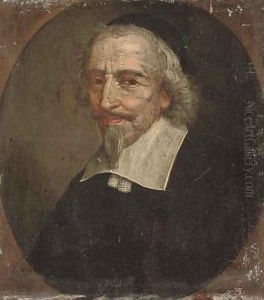Phillippe De Champagne Paintings
Philippe de Champaigne was a prominent painter of the French Baroque era, born in Brussels, which was then part of the Spanish Netherlands, on May 26, 1602. Despite his Flemish origins, his artistic career is intimately tied to France, where he spent most of his life and developed his craft. Champaigne demonstrated artistic talent early on and was sent to Paris at the age of nineteen, where he became a part of the thriving artistic community.
In Paris, Champaigne worked under the guidance of renowned painter Georges Lallemand. His talent quickly garnered the attention of influential patrons, which led to his participation in the decoration of the Luxembourg Palace under the direction of Nicolas Duchesne. Upon Duchesne's death, Champaigne assumed his role and continued the project, which significantly bolstered his reputation.
Champaigne's style was characterized by its realism and adherence to classical artistic values, which were partly a reaction against the ornate and dynamic style of his contemporaries in the Baroque movement. His works often reflected a sober and direct approach, with careful attention to detail and a restrained palette. He became particularly well-known for his religious compositions, portraits, and still life paintings.
In 1628, Champaigne became one of the founding members of the Académie Royale de Peinture et de Sculpture, an institution that played a central role in the development of the arts in France. His association with the French court was solidified when he became the official artist for Queen Marie de Medici and later served King Louis XIII and Cardinal Richelieu. Among his notable works from this period are the portraits of Cardinal Richelieu and the series of paintings for the church of the Sorbonne, including 'The Annunciation', 'The Crucifixion', and 'The Adoration of the Shepherds'.
Philippe de Champaigne's career was also marked by personal tragedy. His daughter, Catherine de Champaigne, became a Jansenist, and her religious convictions deeply influenced the artist. This is evident in some of his later works, which are imbued with a sense of austere piety. Champaigne's painting 'Ex Voto de 1662' features his daughter and is considered one of his masterpieces, notable for its emotional depth and spiritual gravity.
Philippe de Champaigne's work was widely acclaimed during his lifetime, and he remained a significant figure in the French art scene until his death in Paris on August 12, 1674. His legacy is a vast body of work that significantly contributed to the development of French painting, and his influence can be seen in the works of later artists who sought to capture the essence of their subjects with honesty and clarity.
